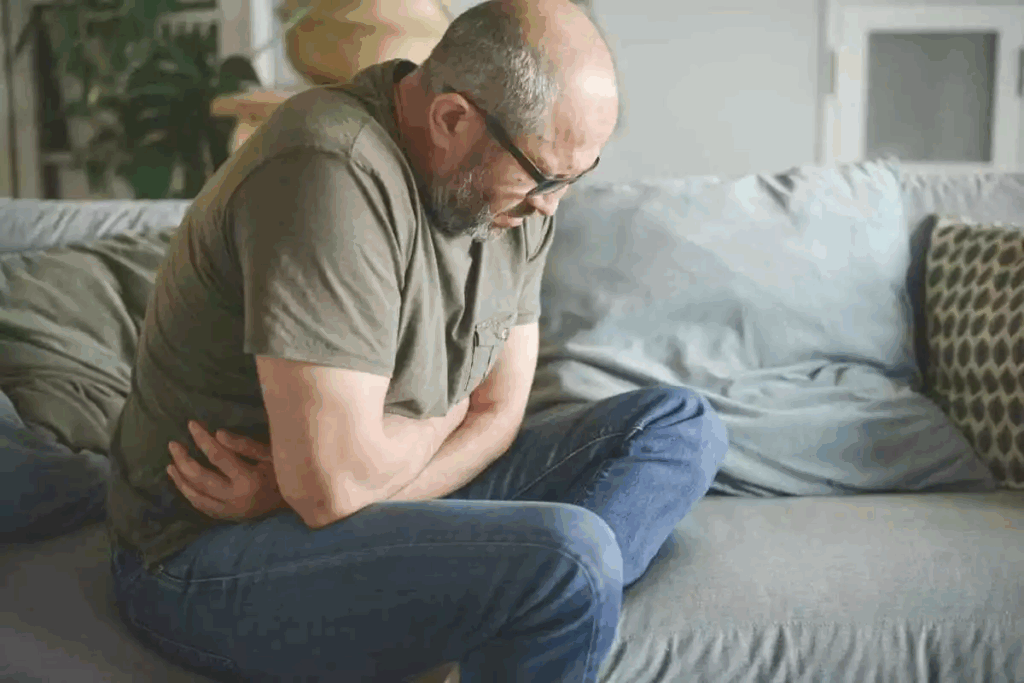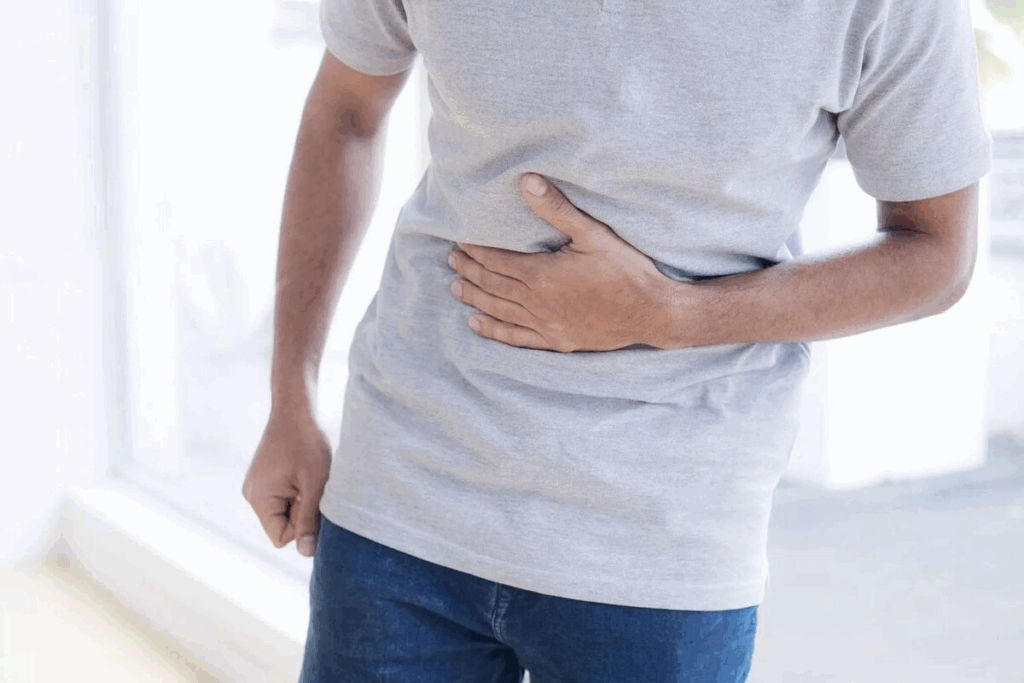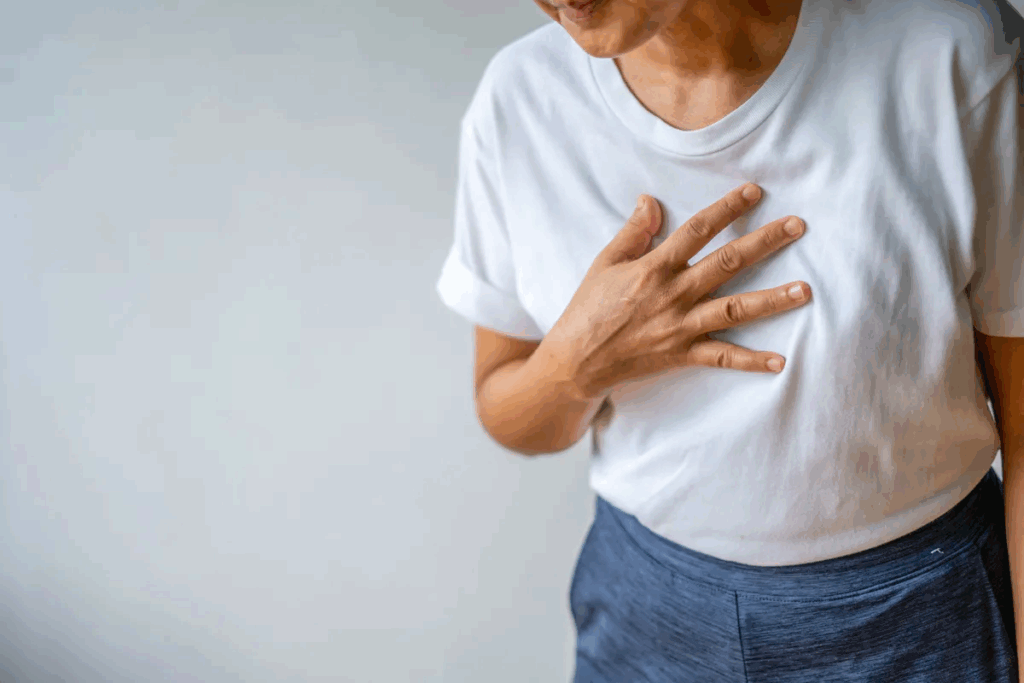Last Updated on October 30, 2025 by Bilal Hasdemir

Feeling sudden pain in your stomach, having a fever, or feeling uncomfortable after eating can be scary. Cholecystitis, or an inflamed gallbladder, is a serious issue that needs quick medical help.Discover what causes an inflamed gallbladder. Learn the shocking facts and if this dangerous inflammation can occur without gallstones.
Cholecystitis usually happens when gallstones block the cystic duct. This causes bile to build up, leading to acute cholecystitis. But, it’s also possible for the gallbladder to get inflamed without gallstones, known as acalculous cholecystitis.
Liv Hospital’s world-class care can diagnose and treat this serious condition. Knowing the causes and symptoms is key to managing it well.

The gallbladder plays a key role in digestion. It stores bile from the liver and releases it into the small intestine. This helps break down fats for better nutrient absorption.
The gallbladder is a small, pear-shaped organ on the right side of the abdomen. It’s below the liver and part of the biliary system. Its main job is to store bile, a yellow-green fluid that helps digest fats.
The Structure of the Gallbladder
The gallbladder has three main parts: the fundus, body, and neck. The fundus is the rounded end facing the abdominal wall. The body stores bile. The neck connects the body to the cystic duct.
Bile is essential for fat digestion. It breaks down fats into smaller parts for absorption. It also helps with the absorption of fat-soluble vitamins (A, D, E, and K).
“Bile is critical for fat digestion and absorption of fat-soluble vitamins in the small intestine.”
The hormone cholecystokinin (CCK) triggers bile release. CCK is secreted by the duodenum in response to fatty foods. This hormone makes the gallbladder contract, releasing bile into the small intestine.
| Component | Function |
| Bile Salts | Emulsify fats for easier digestion |
| Bilirubin | A byproduct of red blood cell breakdown |
| Cholesterol | Excess cholesterol is excreted into bile |
Knowing about the gallbladder’s anatomy and function is key. It helps us understand gallbladder inflammation and its effects on digestion.

It’s important to know why a gallbladder gets inflamed. Gallstones aren’t the only reason. There are many causes, and knowing them helps doctors treat the problem right.
Gallstones are hard pieces of bile that can block the cystic duct. This blockage stops bile from leaving the gallbladder. It builds up and can cause inflammation.
Gallstone Formation: Gallstones can be tiny or huge. They form from cholesterol or bilirubin. Diet, obesity, and genetics play a role in their formation.
While gallstones are common, other things can also cause gallbladder inflammation. These include:
| Cause | Description | Risk Factors |
| Gallstones | Blockage of the cystic duct by gallstones | Diet, obesity, genetics |
| Infection | Bacterial infection of the gallbladder | Weakened immune system |
| Trauma | Severe abdominal injury | Accidents, physical trauma |
| Severe Illness | Critical illness leading to acalculous cholecystitis | Critical care, major surgery |
Knowing the causes of cholecystitis is key to treating it. Gallstones are the main cause, but other factors can also lead to it. A full understanding is needed for effective treatment.
Gallstones blocking the bile duct can cause calculous cholecystitis. This painful condition needs quick medical help. It happens when gallstones block the bile duct, causing the gallbladder to get inflamed.
Gallstones blocking the bile duct is the main cause of calculous cholecystitis. When a gallstone blocks the bile duct, it stops bile from leaving the gallbladder. This leads to a buildup of bile and inflammation.
The process involves several key steps:
Knowing the risk factors for gallstones is key to preventing calculous cholecystitis. Several factors can increase the chance of getting gallstones:
| Risk Factor | Description |
| Obesity | Being overweight or obese increases the risk of gallstone formation. |
| Diet | A diet high in fat and cholesterol can increase the risk of gallstones. |
| Family History | A family history of gallstones increases an individual’s risk. |
| Age and Gender | Women and older adults are more likely to develop gallstones. |
By knowing these risk factors and how gallstones block the bile duct, people can lower their chance of getting calculous cholecystitis.
Acalculous cholecystitis is a serious and often missed cause of gallbladder inflammation in very sick patients. It’s different from the usual kind because it happens without gallstones. This makes it harder to treat.
This condition is common in the ICU or among hospitalized patients. It’s a big deal because it makes caring for very sick patients even harder.
Key Statistics:
| Population | Prevalence | Mortality Rate |
| Critically ill patients | 0.2-2.4% | Up to 50% |
| ICU patients | 1-4% | 30-50% |
Several things can make someone more likely to get acalculous cholecystitis. These include not eating for a long time, getting total parenteral nutrition, having big surgery, getting hurt badly, or having a severe infection. These situations can cause the gallbladder to not work right and get inflamed.
Risk Factors for Acalculous Cholecystitis:
Knowing about these risk factors is key to spotting and treating acalculous cholecystitis early. This can help make things better for those who get it.
When the gallbladder doesn’t contract or empty properly, it can lead to a condition known as biliary dyskinesia. This condition is characterized by impaired gallbladder motility. It can cause various gastrointestinal symptoms, including abdominal pain and discomfort.
Biliary dyskinesia is often associated with gallbladder pain when breathing or moving. This can be quite distressing for those affected. Understanding the causes and symptoms of this condition is key for effective diagnosis and management.
Gallbladder motility issues, such as those seen in biliary dyskinesia, can result from various factors. These include muscle dysfunction or obstruction of the bile ducts. The gallbladder plays a vital role in digestion by storing and releasing bile into the small intestine.
When the gallbladder doesn’t function correctly, it can lead to digestive problems and discomfort. The diagnosis of biliary dyskinesia often involves assessing the gallbladder’s ability to contract and empty.
Diagnosing biliary dyskinesia typically involves a combination of clinical evaluation and diagnostic tests. One common test used is the HIDA scan. It evaluates the gallbladder’s function and ability to empty.
Management approaches for biliary dyskinesia may include medications to manage symptoms or, in some cases, surgical intervention such as cholecystectomy. The choice of treatment depends on the severity of symptoms and the underlying cause of the condition.
It’s essential for individuals experiencing persistent or severe symptoms to consult with a healthcare professional. They can provide proper evaluation and treatment.
Infections are a big reason for gallbladder inflammation, more so in those with weak immune systems. The gallbladder can get sick from many infections, like bacteria, viruses, and parasites.
Bacterial infections are a major cause of cholecystitis, mainly in people with health issues. Gram-negative bacteria like Escherichia coli and Klebsiella are often to blame.
| Bacterial Species | Common Associations |
| Escherichia coli | Urinary tract infections, biliary tract infections |
| Klebsiella species | Respiratory tract infections, biliary tract infections |
| Staphylococcus species | Skin infections, endocarditis |
Viral and parasitic infections can also cause gallbladder inflammation. For example, Leptospirosis, caused by Leptospira, can affect the gallbladder and other organs. Parasites like Giardia lamblia can cause stomach problems that might affect the gallbladder too.
To diagnose infection-related cholecystitis, doctors look for the cause through tests. Treatment includes the right antibiotics and supportive care.
In intensive care, patients face a risk of acalculous cholecystitis. This is due to trauma, critical illness, and less blood to the gallbladder. It’s a big worry because it happens without gallstones, making it hard to diagnose and treat.
After surgery, the risk of gallbladder inflammation goes up. Post-surgical complications like acalculous cholecystitis are a big concern. This is true for critically ill patients or those who had major surgery.
Factors that raise the risk include fasting for a long time, total parenteral nutrition, and certain meds. Watching patients closely after surgery is key. This is because they might show signs like pain, fever, or jaundice. Catching these early can really help.
Ischemic cholecystitis happens when blood flow to the gallbladder stops or drops. This leads to damage and inflammation. It can come from critical illness, trauma, or vascular diseases.
It’s hard to spot because symptoms are not clear. But, it’s important to think of it in sick patients with belly pain. Quick action is key to avoid more problems.
Handling ischemic cholecystitis means fixing the blood flow issue. It also means taking care of symptoms and preventing more harm. Sometimes, surgery is needed to fix the gallbladder or get blood flowing again.
Knowing about the dangers of trauma, critical illness, and less blood flow is key. Early action and right treatment can make a big difference for patients.
It’s important to know the signs of gallbladder inflammation to avoid serious problems. An inflamed gallbladder, or cholecystitis, shows different symptoms. These symptoms can range from mild to severe.
The symptoms of an inflamed gallbladder include severe pain in the right upper abdomen, fever, and nausea. The pain can be steady or come and go. It might also spread to the back or right shoulder.
Other signs include:
In some cases, an inflamed gallbladder without gallstones can happen. This is more common in very sick patients or those with other health issues.
Pain that gets worse with deep breathing is a key sign of an inflamed gallbladder. This pain can be sharp or dull. It often gets worse with movement or deep breathing.
If you have any of these symptoms, you should seek medical attention right away:
Getting a diagnosis and treatment early can greatly improve your chances of recovery. It can also prevent serious complications.
Healthcare providers use many tools to diagnose gallbladder inflammation. They use imaging techniques and laboratory tests. This helps confirm cholecystitis and rule out other conditions with similar symptoms.
Ultrasound is often the first choice for diagnosing gallbladder inflammation. It can spot gallstones, thickened gallbladder walls, and fluid around the gallbladder. These signs point to cholecystitis. Ultrasound is great because it’s non-invasive and doesn’t use radiation.
In some cases, Computed Tomography (CT) scans are used. They give detailed images of the gallbladder and nearby areas. This helps spot severe inflammation or complications.
Laboratory tests are key in diagnosing gallbladder inflammation. They check for signs of inflammation and infection. Tests include:
The symptoms of gallbladder inflammation can be similar to other conditions. So, differential diagnosis is very important. Healthcare providers must think of other possible causes, like gastrointestinal issues or liver disease. This ensures they get the right diagnosis.
By looking at imaging studies and lab results, along with a detailed clinical evaluation, doctors can accurately diagnose gallbladder inflammation. Then, they can create a proper treatment plan.
Untreated gallbladder inflammation can cause severe problems. The gallbladder is key to digestion. When it’s inflamed, it can lead to serious health issues.
A neglected gallbladder can be fatal. Gallbladder inflammation can lead to gangrene, perforation, and sepsis, which are life-threatening. Older adults and those with health issues face a higher risk of death.
Gallstones increase the risk of cholecystitis. But, inflammation can happen without stones, known as acalculous cholecystitis. This is common in critically ill patients and can be deadly due to late diagnosis.
Untreated cholecystitis can lead to sepsis, a deadly condition. It happens when the body’s infection response gets out of control. Sepsis can cause organ failure and death if not treated quickly.
Chronic gallbladder inflammation can cause long-term issues. This includes chronic pain and recurring infections. It can also lead to severe conditions like gallbladder cancer, though rare.
Seeking medical help for persistent symptoms is vital. Early diagnosis and treatment can greatly improve outcomes for those with cholecystitis.
Dealing with cholecystitis means knowing about treatment options. This includes medical care and removing the gallbladder. The right choice depends on how bad the condition is, if there are complications, and the patient’s health.
For mild cholecystitis, doctors might start with medical treatment. This usually includes:
Medical treatment can help symptoms and might avoid surgery. But, if the problem is serious or keeps coming back, surgery might be needed.
Removing the gallbladder is often advised for severe or recurring cholecystitis. Laparoscopic cholecystectomy is a common method. It uses small cuts, causes less pain, and leads to faster healing than open surgery.
| Surgical Approach | Benefits | Risks |
| Laparoscopic Cholecystectomy | Minimally invasive, less postoperative pain, quicker recovery | Risk of bile duct injury, possible need for open surgery |
| Open Cholecystectomy | Direct access, good for complex cases | Larger cut, more pain, longer healing |
Most people can live normally after gallbladder removal. But, some changes might be needed:
It’s key to follow your doctor’s advice on care and lifestyle changes. This helps in a smooth recovery and a good quality of life.
Knowing why gallbladders get infected is key to preventing and managing gallbladder disease. By understanding the causes, people can take steps to lower their risk.
Preventing gallbladder inflammation is important. Keeping a healthy weight through diet and exercise can help. Eating a low-fat diet with lots of fruits, veggies, and whole grains is also beneficial.
It’s also vital to manage health conditions like diabetes and high blood pressure. Regular health check-ups can catch problems early, leading to better care.
Managing gallbladder disease requires both medical care and lifestyle changes. By making these changes, people can lower their risk of gallbladder problems. This improves their quality of life.
Preventing gallbladder disease is essential to avoid its discomfort and complications. By knowing the causes and taking action, people can keep their gallbladders healthy and well.
Gallbladder inflammation can happen for several reasons. Gallstones blocking the bile duct are a common cause. Infections, severe illnesses, trauma, or decreased blood flow can also lead to inflammation. Sometimes, inflammation occurs without gallstones, known as acalculous cholecystitis.
Yes, it’s possible to have an inflamed gallbladder without gallstones. This is called acalculous cholecystitis. It often happens due to severe illness, trauma, or decreased blood flow.
Symptoms include severe pain in the right upper abdomen, fever, nausea, and vomiting. The pain can spread to the back or right shoulder. It gets worse with deep breathing.
Doctors use imaging like ultrasound or CT scans to diagnose. They also do lab tests to check for inflammation and infection. A thorough clinical evaluation is key to make the right diagnosis.
Untreated inflammation can cause serious problems. These include sepsis, gangrene, or perforation of the gallbladder. These can be life-threatening. Long-term inflammation can also cause lasting health issues.
Yes, a severely inflamed or infected gallbladder can be deadly if not treated. Quick medical care is vital to avoid serious complications.
Treatment may start with antibiotics and pain relief. But often, surgery like cholecystectomy (gallbladder removal) is needed. This is true for severe cases or when gallstones are involved.
After removing the gallbladder, the body adjusts. Bile flows directly from the liver to the small intestine. Most people can live normally without long-term problems.
Preventing gallbladder disease is possible. Keep a healthy weight, eat well, stay hydrated, and manage risk factors for gallstones. Regular health check-ups help in early detection and management.
Biliary dyskinesia is when the gallbladder doesn’t work right. It’s often due to motility issues. It can cause symptoms like gallbladder inflammation. Specific tests are used to diagnose it.
Subscribe to our e-newsletter to stay informed about the latest innovations in the world of health and exclusive offers!
WhatsApp us